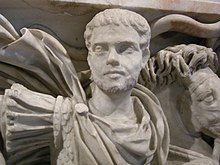| Hostilian | |||||
|---|---|---|---|---|---|
 Marble figure of Hostilian, from the Ludovisi Battle sarcophagus | |||||
| Joint 36th Emperor of the Roman Empire | |||||
| Reign | 251 (with Trebonianus Gallus) | ||||
| Predecessor | Decius and Herennius Etruscus | ||||
| Successor | Trebonianus Gallus and Volusianus | ||||
| Co-emperor | Trebonianus Gallus | ||||
| Born | c. 230 Sirmium, Pannonia (present-day Serbia) | ||||
| Died | 251 (age 21) Viminacium, Moesia (present-day Serbia) | ||||
| |||||
| Father | Decius | ||||
| Mother | Herennia Etruscilla | ||||
Hostilian (Latin: Gaius Valens Hostilianus Messius Quintus Augustus; 230? – November 251) was Roman emperor in 251, from July to November.
History
editHostilian was born at an unknown date, to Decius, a Roman general who later became Emperor, and Herennia Etruscilla, his wife. Decius became emperor after being sent to lead troops in the provinces of Pannonia and Moesia, where he was declared emperor by his troops in September 249, in opposition to Philip the Arab. He led his troops against Philip, their forces meeting in September 249, near Verona, Italy. In this battle, Philip was slain, after which the Roman Senate declared Decius emperor, and honored him with the name Traianus, a reference to Emperor Trajan.[1][2][3]
Hostilian was elevated to caesar in May 251, by his father Decius.[1][4] This was done after the elevation of his older brother Herennius Etruscus to augustus in the same month, making Herennius Etruscus junior emperor, with Hostilian as the designated heir of either of them.[1][4][5] After Decius and Herennius Etruscus were killed by the Goths in an ambush in July 251, at the Battle of Abritus, Trebonianus Gallus was declared emperor. In order to placate the people, Trebonianus Gallus elevated Hostilian to augustus almost immediately, making him co-emperor.[6][1][7] Hostilian was co-emperor until November 251, when he died, although the reason for his death is disputed.[1][7] Aurelius Victor and the author of the Epitome de Caesaribus both say that Hostilian died of a plague, however Zosimus claims that he was killed off by Trebonianus Gallus.[8] After his death, Trebonianus Gallus made Volusianus, his son, co-emperor.[1]
Numanistics
editThe aurei of Hostilian fell into four types. All four types bore the bust of Hostilian on the obverse, with the reverse showing: Mars walking to the right, priestly implements, Mercury standing, and Roma seated holding Victoria.[9]
References
editPrimary sources
edit- De Caesaribus (30.2) by Aurelius Victor.[10]
- Epitome de Caesaribus (30.2) by Anonymus.[10]
- Historia Nova (1.25.1) by Zosimus.[8]
Citations
edit- ^ a b c d e f Adkins & Adkins 1998, p. 28.
- ^ Chrystal 2015, p. 193.
- ^ Varner 2004, p. 207.
- ^ a b Salisbury & Mattingly 1924, p. 15.
- ^ Bunson 2014, p. 265.
- ^ Bunson 2014, pp. 255–256.
- ^ a b Salisbury & Mattingly 1924, p. 16.
- ^ a b Manders 2012, p. 18.
- ^ Friedberg, Friedberg & Friedberg 2017, p. 48.
- ^ a b Haas 1983, p. 134.
Bibliography
edit- Adkins, Lesley; Adkins, Roy A. (1998). Handbook to Life in Ancient Rome. Oxford University Press. ISBN 9780195123326.
- Bunson, Matthew (2014). Encyclopedia of the Roman Empire. Facts On File. ISBN 9781438110271.
- Chrystal, Paul (2015). Roman Women: The Women who influenced the History of Rome. Fonthill Media. ISBN 978-1781552872.
- Friedberg, Arthur L.; Friedberg, Ira S.; Friedberg, Robert (2017). Gold Coins of the World - 9th edition: From Ancient Times to the Present. An Illustrated Standard Catlaog with Valuations. Coin & Currency Institute. ISBN 9780871840097.
- Haas, Christopher J. (1983). "Imperial Religious Policy and Valerian's Persecution of the Church, A.D. 257-260". Church History. 52 (2): 133–144. doi:10.2307/3166947. JSTOR 3166947. S2CID 159885531.
- Manders, Erika (2012). Coining Images of Power: Patterns in the Representation of Roman Emperors on Imperial Coinage, A.D. 193 - 284. Brill. ISBN 9789004189706.
- Salisbury, F. S.; Mattingly, H. (1924). "The Reign of Trajan Decius". The Journal of Roman Studies. 14: 1–23. doi:10.2307/296323. JSTOR 296323.
- Varner, Eric R. (2004). Multilation and Transformation: Damnatio Memoriae and Roman Imperial Portaiture. Brill. ISBN 978-9004135772.